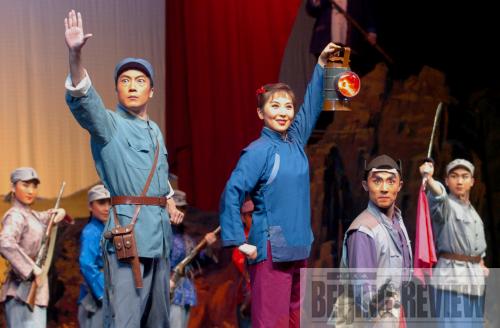|
 |
|
MODEL OPERA: The Red Lantern is one of eight model operas with revolutionary themes created in the 1970s. Model opera represented the third boom for Peking Opera (ZHU XIANG) |
"Of all entertainments and recreations during that period, Peking Opera was the one that attracted both aristocrats and street vendors, and mainly portrayed loyal officials, martyrs and love affairs between talent and beauty. It became an import vehicle for moral lessons at the late-Qing period," said qingyi player Li Zhenghua. Qingyi refers to a modest and virtuous female role.
Peking Opera met its second developmental boom from the 1920s to the 1940s when "four great dans" (all male actors in female roles)—Mei Lanfang, Cheng Yanqiu, Shang Xiaoyun and Xun Huisheng-- conquered audiences nationwide with distinctly different performing styles.
During this period, three technological innovations--movie, phonograph and railway--accounted for an increase in Peking Opera's accessiblity and popularity with a larger audience outside Beijing, leading to the four great dans rise to national stardom, Li said.
China's first movie Mount Dingjun, for example, featured Tan Xinpei in 1905. The country's first color movie, Wedding in the Dream-Remorse at Death, also featured Peking Opera performance, in which Mei Lanfang played the leading role in 1948. "Thanks to movies, we can still see master Mei alive on the silver screen. Compared with live performances, movies provide a much cheaper way for art dissemination that exceeds the limitations of time and space," Li said.
In a similar way, the phonograph and railway helped Peking Opera spread. Railways sent Beijing-based masters to Shanghai and wherever an audience had an interest. With the help of the passenger ship, Mei even brought Peking Opera outside China, arriving in the United States in 1930, while Cheng Yanqiu paid visits to European countries to study Western opera in 1932.
The third boom created the model opera, a modern form of Peking Opera that focused only on revolutionary themes in the 1970s. However, many observers denied it as a developmental boom because "it allowed model opera to prevail and thus almost extinguished traditional pieces that pay equal emphasis to skills of singing, reciting, movement, fighting and tumbling, as well as costumes," Tan said.
Except for interests in model operas that were renewed in the late 1980s, traditional pieces of Peking Opera have gradually lost appeal to younger audiences, in part because the youth have more options when it comes to entertainment, and overseas cultural products such as music, movies and books began to flood the market after the implementation of reform and opening-up policy.
The beauty of Peking Opera
Peking Opera is a harmonious combination of the Grand Opera, ballet and acrobatics. It also presents the audience with an encyclopedia of Chinese culture through unfolding stories, beautiful paintings, exquisite costumes and martial arts.
For many overseas audiences, Peking Opera represents a cultural symbol designers often look to for inspiration or exotic souvenirs, like painted facial masks that tourists often bring home. For others, it represents a completely unique experience not offered in Western operas.
Originally, Peking Opera was performed mostly on stage in the open air, at teahouses or temple courtyards. Performers developed a piercing style of singing for everyone to hear. The costumes were a garish collection of sharply contrasting colors to stand out on the dim stage.
"The beauty of Peking Opera lies with how the performers sing, not with how they act out the plots," renowned scholar Ji Xianlin wrote in his preface to The Intellectual Request Into Peking Opera. "Senior opera lovers always listen to, instead of seeing, a piece of opera, because they are too familiar to be interested in the plots, which usually came from classical historical novels such as Romance of the Three Kingdoms."
Within the Intellectual Request Into Peking Opera, Xu Chengbei, a seasoned observer and scholar in the culture of Peking Opera, told the history of Peking Opera and anecdotes of Peking Opera performers.
| 